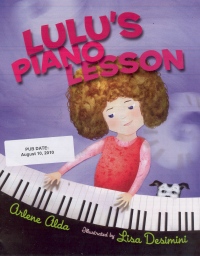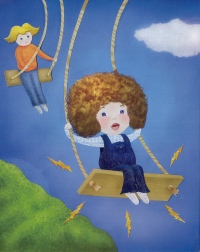| ________________
CM . . .
. Volume XVII Number 1. . . .September 3, 2010 
 |
Lulu's Piano Lesson.
Arlene Alda. Illustrated by Lisa Desimini.
Toronto, ON: Tundra Books, 2010.
32 pp., hardcover, $18.99.
ISBN 978-0-88776-930-6.
Kindergarten-grade 3 / Ages 5-8.
Review by Devon Greyson.
** /4
Reviewed from Advance Review Copy.
|
| |
|

excerpt:
On Tuesday...
Rrrrring, rrrrring. Lulu pressed the bell on her bike as she and her best friend, Marcie, rode around the corner. Rrrrring, rrrrring, as they warned the squirrels to get out of their way. Lulu felt the breeze blowing her hair back from her face. She sang, "Better watch out. Here we come, ring-a-ring-a-ring!"
Lulu passed her front door just as Mom called out, "Time to practice the piano. It's nearly dinnertime."
"Soon…soon," called out Lulu, as she and Marcie whizzed by once again.
"Soon" came and "soon" went, as Lulu happily rode on her bike with Marcie.
All week long, Lulu ignores her mother's reminders to practice the piano. Instead, she plays inside and out with her friend and sister, brushing off her mother with "In ten minutes" each day. Friday afternoon, however, is piano lesson time, and the fun is suddenly gone when an unprepared Lulu must go to see Mr. Sharp.
With her stomach roiling inside of her, Lulu confesses that she didn't practice this week. Surprisingly, Mr. Sharp asks her about her week and what she did rather than practice the piano. Lulu tells her kindly teacher about the musical sounds she did hear during her play, and he cleverly spins this into a music lesson, moving her from singing the various sounds to playing the piano. At story's end, Lulu's stomach feels better, and she skips home to practice the piano.
Lulu's Piano Lesson highlights a feeling common to many child music students – guilt over failing to practice between lessons. Arlene Alda's description of Lulu's activities and feelings feels true, and the prose is clear. The language is age-appropriate for early elementary children, with some good sound and instrument vocabulary embedded within.
The first half of the book follows the pattern of naming the day of the week, describing the after-school activity, identifying the sound Lulu hears, brushing off Mom's reminder to practice, and time passing by without any piano practicing. The second half of the book, in contrast, is focused on recalling the sounds collected over the week while playing and on Lulu's inner emotional drama of the piano lesson.
 Lisa Desimini's illustrations in cut-paper collage format are bright, colourful and full of texture. The best part of this book is the neat visual depiction of the various sounds, which is both subtle and easy for children to identify. There is also hidden musical content in the illustrations – for example, overhead power lines with birds on them designed to look like musical staves with notes. The pictures have a fresh, contemporary look, with the exception of the fact that Lulu appears to live in an entirely Caucasian, suburban world.
Lisa Desimini's illustrations in cut-paper collage format are bright, colourful and full of texture. The best part of this book is the neat visual depiction of the various sounds, which is both subtle and easy for children to identify. There is also hidden musical content in the illustrations – for example, overhead power lines with birds on them designed to look like musical staves with notes. The pictures have a fresh, contemporary look, with the exception of the fact that Lulu appears to live in an entirely Caucasian, suburban world.
Some may question the realism of the story. Lulu seems to have the world's most patient piano teacher who chooses to ask about what fun things she did all week rather than reprimand her for not practicing. Adults, in particular, may wonder why the mother character is so weak; and, for example, may question why she doesn't require Lulu to practice as a condition of taking lessons. Because readers don't know whether Lulu is normally diligent about practicing, or whether this is chronic behaviour on her part, it may be a little hard to interpret how her choices fit in with the clear expectation that she will practice the piano on her own.
Additionally, in Lulu's all-female world (except for the tuxedo-clad teacher), there is not much visible action. This is a book for quieter children, likely girls, for whom the inner drama of Lulu's anxiety about her lesson is enough excitement to make a story compelling.
This book is probably not one for group use, despite the engaging illustrations, but it would be appropriate in a library or collection for an early elementary audience. Some music teachers will enjoy its message while others will certainly not. However, for those children who identify with Lulu's feelings of guilt, it may be an effective vehicle for discussing positive resolutions of anxiety, or just an enjoyable story.
Recommended.
Devon Greyson is a librarian at the Centre for Health Services and Policy Research in Vancouver, BC.

To comment
on this title or this review, send mail to cm@umanitoba.ca.
Copyright © the Manitoba Library Association. Reproduction for personal
use is permitted only if this copyright notice is maintained. Any
other reproduction is prohibited without permission.
NEXT REVIEW |
TABLE OF CONTENTS FOR THIS ISSUE
- September 3, 2010.
AUTHORS |
TITLES |
MEDIA REVIEWS |
PROFILES |
BACK ISSUES |
SEARCH |
CMARCHIVE |
HOME |

 Lisa Desimini's illustrations in cut-paper collage format are bright, colourful and full of texture. The best part of this book is the neat visual depiction of the various sounds, which is both subtle and easy for children to identify. There is also hidden musical content in the illustrations – for example, overhead power lines with birds on them designed to look like musical staves with notes. The pictures have a fresh, contemporary look, with the exception of the fact that Lulu appears to live in an entirely Caucasian, suburban world.
Lisa Desimini's illustrations in cut-paper collage format are bright, colourful and full of texture. The best part of this book is the neat visual depiction of the various sounds, which is both subtle and easy for children to identify. There is also hidden musical content in the illustrations – for example, overhead power lines with birds on them designed to look like musical staves with notes. The pictures have a fresh, contemporary look, with the exception of the fact that Lulu appears to live in an entirely Caucasian, suburban world.